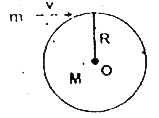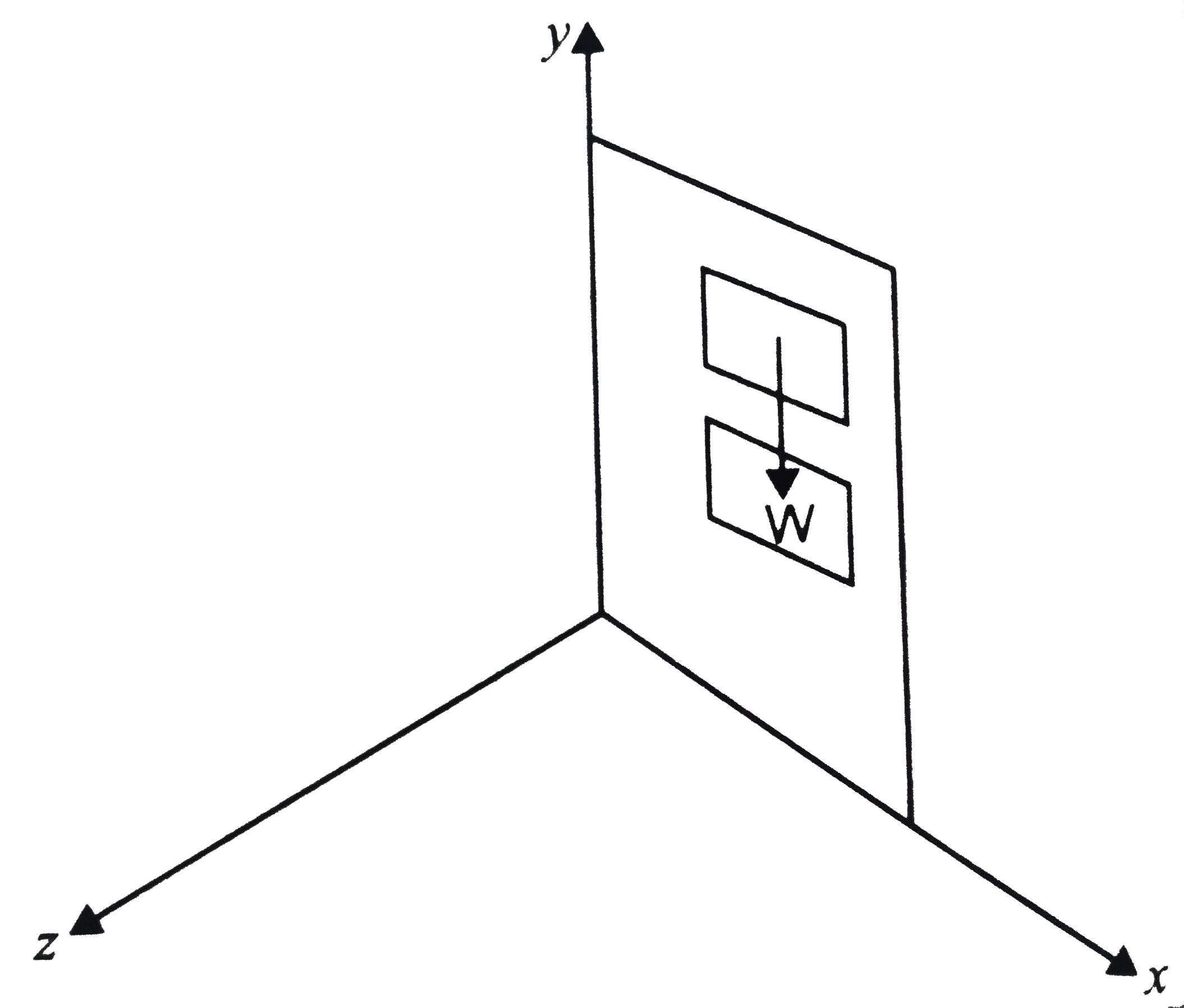A bullet of mass 10g and speed 500m/s is fired into a door and gets embedded exactly at the centre of the door. The door is 1.0m wide and weight 12kg. It is hinged at one end and rotates about a vertical axis practically without friction. Find the angular speed of the door just after the bullet embeds into it.(Hint. The moment of inertia of the door about the vertical axis at one end is ML2/3)
To solve the problem, we will use the principle of conservation of angular momentum. The steps are as follows:
Step 1: Identify the initial and final states
Initially, the bullet is moving with a speed of 500 m/s, and the door is at rest. After the bullet embeds itself in the door, the system (door + bullet) will rotate together.
Step 2: Calculate the initial angular momentum
The initial angular momentum (L_initial) is due only to the bullet since the door is at rest. The angular momentum can be calculated using the formula:
L=m⋅v⋅r
where:
- m = mass of the bullet = 10 g = 0.01 kg (convert grams to kilograms)
- v = speed of the bullet = 500 m/s
- r = perpendicular distance from the hinge to the line of motion of the bullet = width of the door / 2 = 1 m / 2 = 0.5 m
Thus, the initial angular momentum is:
Linitial=m⋅v⋅r=0.01kg⋅500m/s⋅0.5m=2.5kg m2/s
Step 3: Calculate the moment of inertia of the door
The moment of inertia (I_door) of the door about the hinge is given by the formula:
Idoor=ML23
where:
- M = mass of the door = 12 kg
- L = width of the door = 1 m
Calculating the moment of inertia:
Idoor=12kg⋅(1m)23=4kg m2
Step 4: Calculate the moment of inertia of the bullet
When the bullet embeds in the door, it can be treated as a point mass at a distance of 0.5 m from the hinge. The moment of inertia (I_bullet) of the bullet is given by:
Ibullet=m⋅r2=0.01kg⋅(0.5m)2=0.01⋅0.25=0.0025kg m2
Step 5: Calculate the total moment of inertia after the bullet embeds
The total moment of inertia (I_total) after the bullet embeds in the door is:
Itotal=Idoor+Ibullet=4kg m2+0.0025kg m2=4.0025kg m2
Step 6: Apply conservation of angular momentum
According to the conservation of angular momentum:
Linitial=Lfinal
Lfinal=Itotal⋅ω
where ω is the angular speed we want to find.
Setting the initial angular momentum equal to the final angular momentum:
2.5kg m2/s=4.0025kg m2⋅ω
Step 7: Solve for angular speed (ω)
Rearranging the equation to solve for ω:
ω=2.54.0025
Calculating ω:
ω≈0.6247rad/s
Final Answer
The angular speed of the door just after the bullet embeds into it is approximately 0.625rad/s.
---
Initially, the bullet is moving with a speed of 500 m/s, and the door is at rest. After the bullet embeds itself in the door, the system (door + bullet) will rotate together.
The initial angular momentum (L_initial) is due only to the bullet since the door is at rest. The angular momentum can be calculated using the formula:
L=m⋅v⋅r
where:
- m = mass of the bullet = 10 g = 0.01 kg (convert grams to kilograms)
- v = speed of the bullet = 500 m/s
- r = perpendicular distance from the hinge to the line of motion of the bullet = width of the door / 2 = 1 m / 2 = 0.5 m
Linitial=m⋅v⋅r=0.01kg⋅500m/s⋅0.5m=2.5kg m2/s
The moment of inertia (I_door) of the door about the hinge is given by the formula:
Idoor=ML23
where:
- M = mass of the door = 12 kg
- L = width of the door = 1 m
Idoor=12kg⋅(1m)23=4kg m2
When the bullet embeds in the door, it can be treated as a point mass at a distance of 0.5 m from the hinge. The moment of inertia (I_bullet) of the bullet is given by:
Ibullet=m⋅r2=0.01kg⋅(0.5m)2=0.01⋅0.25=0.0025kg m2
The total moment of inertia (I_total) after the bullet embeds in the door is:
Itotal=Idoor+Ibullet=4kg m2+0.0025kg m2=4.0025kg m2
According to the conservation of angular momentum:
Linitial=Lfinal
Lfinal=Itotal⋅ω
where ω is the angular speed we want to find.
2.5kg m2/s=4.0025kg m2⋅ω
Rearranging the equation to solve for ω:
ω=2.54.0025
ω≈0.6247rad/s
The angular speed of the door just after the bullet embeds into it is approximately 0.625rad/s.
Topper's Solved these Questions
- SYSTEMS OF PARTICLES AND ROTATIONAL MOTIONBook:PRADEEPChapter:SYSTEMS OF PARTICLES AND ROTATIONAL MOTIONExercise:QUESTIONS
Explore 15 Videos
- SYSTEMS OF PARTICLES AND ROTATIONAL MOTIONBook:PRADEEPChapter:SYSTEMS OF PARTICLES AND ROTATIONAL MOTIONExercise:VALUE BASED QUESTIONS
Explore 5 Videos
- SYSTEMS OF PARTICLES AND ROTATIONAL MOTIONBook:PRADEEPChapter:SYSTEMS OF PARTICLES AND ROTATIONAL MOTIONExercise:NCERT
Explore 21 Videos
- RAY OPTICSBook:PRADEEPChapter:RAY OPTICSExercise:Problem For Practice(a)
Explore 25 Videos
- THERMODYNAMICSBook:PRADEEPChapter:THERMODYNAMICSExercise:Assertion- Reason Type Questions
Explore 19 Videos
Similar Questions
Knowledge Check
The moment of inertia of a door of mass m, length 2l and width l about its longer side is.
A11ml224B5ml224Cml23Dnone of theseA bullet of mass m moving with a speed v strikes a wooden block of mass M & gets embedded into the block. The final speed is
A√MM+nVB√mM+nVCmM+nVDV2A bullet of mass 0.1 kg is fired with a speed of 100 m/sec , the mass of gun is 50 kg . The velocity of recoil is
A0.2m/secB0.1m/secC0.5m/secD0.05m/sec
A bullet of mass m collides inelastically at the periphery of a disc of mass M and radius R, with a speed v as shown. The disc rotates about a fixed horizontal axis. Find the angular velocity of the disc bullet system just after the impact.

View SolutionA bullet of mass 25 g is fired horizontally into a ballistic pendulum of mas 5.0 kg and gets embedded in it figure. If the cwentre of the pendulum rises by a distance of 10 cm, find the speed of the bullet.
View SolutionA 50 g bullet is fired from a 10 kg gun with a speed of 500 ms−1. What is the speed of the recoil of the gun.
View SolutionWhy the handles of the doors are at maximum distance from the hinges?
View SolutionA man fires a bullet of mass 200 g at a speed of 5 m/s . The gun is of one kg mass. By what velocity the gun rebounds backwards
View Solution


